Intel's Core i7 870 & i5 750, Lynnfield: Harder, Better, Faster Stronger
by Anand Lal Shimpi on September 8, 2009 12:00 AM EST- Posted in
- CPUs
New Heatsinks and Motherboards
LGA-1156 processors use a different heatsink than both LGA-1366 and LGA-775 chips.
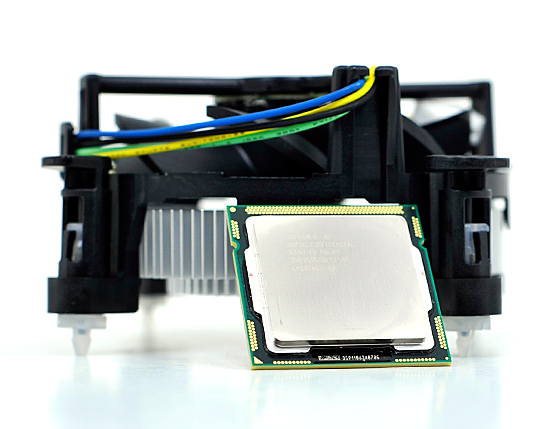
Lynnfield and its cooler
As the numbers would imply, the LGA-1156 heatsink has a larger footprint than LGA-775 but smaller than LGA-1366.
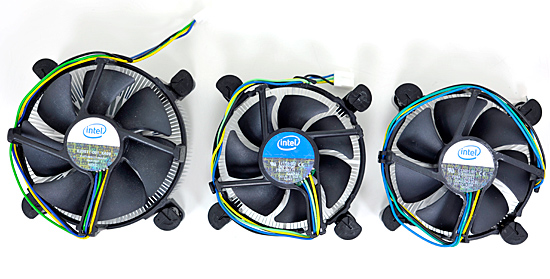
From Left to Right: Retail LGA-1366 Cooler, Retail LGA-1156 Cooler, Retail 45nm LGA-775 Cooler
The retail LGA-1156 is actually much closer to the 45nm LGA-775 retail cooler than the LGA-1366 retail HSF:
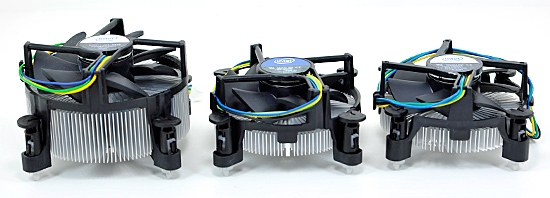
As you'll see later on in the article, the retail cooler isn't very good for heavy overclocking. Power users will want something a little bigger:
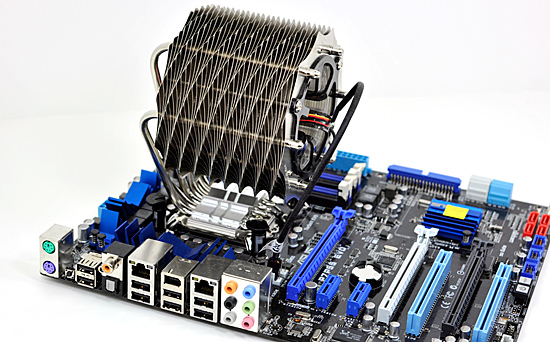
The Lynnfield/P55 launch is huge. Virtually every single motherboard manufacturer has a P55 board available. Prices range from ~$110 - $300 depending on the number of bells and whistles.

Gigabyte's ultra high end UD6 (left) and Gigabyte's lower end micro-ATX UD4 (right)
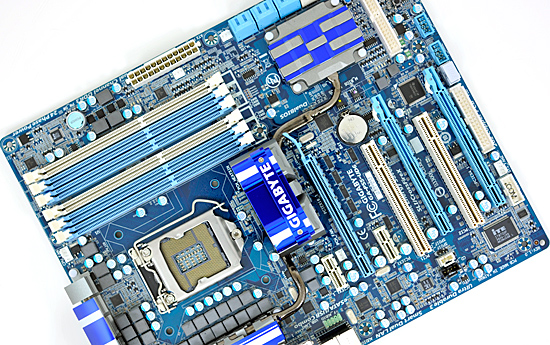
Gigabyte's high end UD6 comes with 6 DIMM slots like its X58 brethren.
Micro-ATX is increasing in popularity and we actually have some good options this time if you're trying to build a smaller Lynnfield system. Combined with Lynnfield's excellent idle power (the lowest of any quad-core we've ever tested), this could make for an unusually potent HTPC.
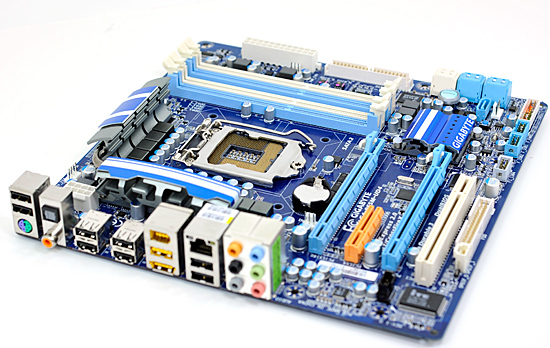
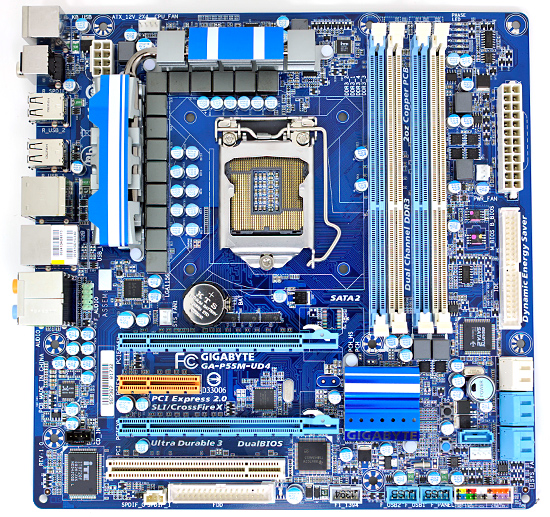
A closer look at Gigabyte's micro-ATX P55M-UD4
The only thing we're really missing is a good mini-ITX Lynnfield board. But perhaps the manufacturers will wait until we have on-package graphics before going down that route...
One More Time: New H55 Boards Next Year
As I subtley implied at the end of the last section, Intel is bringing on-package graphics to Nehalem starting in Q4 of this year:
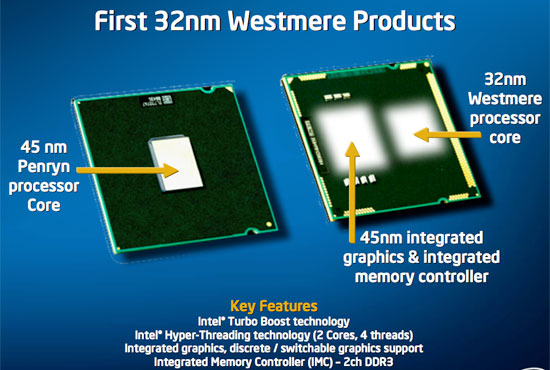
The 32nm Nehalem shrink, codenamed Westmere, will be available with a 45nm Intel graphics core on the processor's package. This graphics core is an evolution of what's currently in the G45 chipset and not Larrabee (although eventually that will change). From what I've heard, this is actually going to be Intel's first reasonably good integrated graphics core.
With the graphics on-package, there needs to be an interface from the processor socket to video output located on the motherboard. As you can see from the P55 motherboards that are launching today: none of them have this video out. Granted there aren't any CPUs out to take advantage of it either.

No DVI/HDMI/VGA out...yet
Early next year (or maybe even late this year) we'll see a new breed of LGA-1156 motherboards with video output, designed for use with these Westmere IGP parts. Rumor has it that these motherboards will use Intel's H55 chipset.
Lynnfield early adopters need not worry, 32nm quad-core processors won't be out for at least a year.










343 Comments
View All Comments
Ann3x - Wednesday, September 9, 2009 - link
1/ There is no chance that any of these chip can run safely with no fan.2/ You dont get huge temperature increases if you dont overvolt, just clock changes result in very small temperature changes. look at the article you linked. The 3 new chips use EXACTLY the same power despite their differing clock speeds.
3/ New energy saving technology works with overclock just like it does with stock clock ed CPUs (eg energy states, my i7 is overclocked to 4ghz on stock volts, when its not needed it clock down - same end effect as these new chips (albeit slightly less elegant)).
This whole fuss about turbo mode is just marketing gumph and yet people are totally sucked in by the hype.
coconutboy - Wednesday, September 9, 2009 - link
1- I never said anything about running the CPU w/o a fan. Fanless watercooling is an option, as is quiet low rpm fans.2- Clocking w/o increasing voltage does increase heat and whether or not you consider that to be a significant amount depends on the cooling solution you use. I made no claim that OC'd temps would increase as much as overvolting.
Your opinion about the validity of turbo mode is just that, you opinion. You and I can agree to disagree.
titanium001 - Wednesday, September 9, 2009 - link
I was excited to see the article, but was left wondering and scratching my head when gaming performance was evaluated. I didn't see any 1920 x 1200 or 2560 x 1600 comparisons anywhere. Do the i7 800 series take a significant performance hit in these settings. I guess everything can't be delivered until a full in depth review. Have to just wait. I'll reserve my judgment about the 800 series until then, for now, it's just another proc. Thanks for the initial preview Anandtech.com.Anand Lal Shimpi - Wednesday, September 9, 2009 - link
Have a look at the SLI/CF Multi-GPU Gaming page, I include some GPU limited tests at the bottom of that page.At higher resolutions P55, X58 and even Phenom II/790FX all perform the same if you're GPU limited. The PCIe limitations of P55/Lynnfield only come into play when you're running in multi-GPU mode because the x16 interface gets broken up into a pair of x8s.
Take care,
Anand
NoobyDoo - Tuesday, September 8, 2009 - link
... remember when C2D was released ?coconutboy - Tuesday, September 8, 2009 - link
After thoroughly reading a lot of the articles at Toms, Anand, xbit etc, Lynnfield looks great and has been worth the wait. However, it's not an absolute sell as a gamer box IMO. My g/f and I have been waiting to build a pair of new gaming computers, but wanted to see what i5 had to offer first. Now that NDAs are down, the $30-70 savings for p55 versus comparable x58 mobos is great, but some things about i5 still make me want an i7 920 instead.My g/f and I plan on buying a pair of GTX 275s, one for each computer. Then later on as our systems age, we'll put both 275s in one box and buy a newer vid card for the other system. We also moderately overclock our CPUs (3.2-3.4 would be what I expect for a i7 920) to boost performance w/o shortening the lifespan too much because our gamer boxes usually end up moving down the line in our home network to become servers or some such.
Taking into account everything I've been reading at hardware sites thus far, we'll likely build one Lynnfield and one i7 for our gaming rigs. I expect one of the current gamer computers we build will migrate to become a VMware machine later on which means an i7 920 w/ (eventually) 24GBs of RAM is very attractive. The ability to use a 6 core CPU later on counts for a lot as well.
coconutboy - Wednesday, September 9, 2009 - link
edit- I meant to be comparing an mildly overclocked i7 920 @ stock voltage and 3.3-3.4GHz versus an i7 860/870, not an i5. I'd often prefer the 920 (but not always of course) for my uses.thebeastie - Tuesday, September 8, 2009 - link
Such a good complete review, EXCEPT there is no information of how much power the CPU used with it was hard overclocked to its 4.2Ghz mark.With its intergrated PCIe 100million transistor count controller inside the CPU this would of been really interesting info.
Gary Key - Wednesday, September 9, 2009 - link
The system power utilized (measured at the wall) was 301W for the 4.2GHz overclock on the 870 under an eight thread 100% load test on the board.justme2009 - Tuesday, September 8, 2009 - link
Why are you overhyping this garbage? I'm waiting for Clarkdale. I'm still ticked off that Intel caved to the manufacturers and held off on releasing it, we were supposed to have it in the 4th quarter of this year, now it will be first half of 2010.This new nehalem (even if it's for desktops) will be nothing compared to the mobile nehalem next year.
My only other question is, why the hell has Clarkdale/Arrendale information been buried? There hasn't been a peep from anyone about it since February.